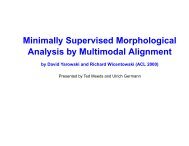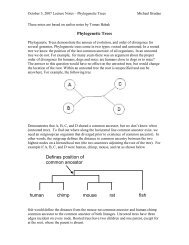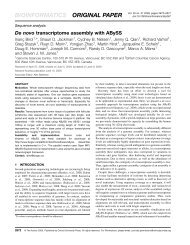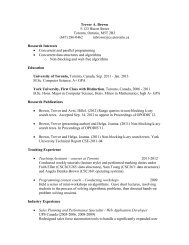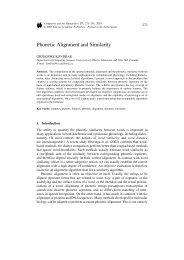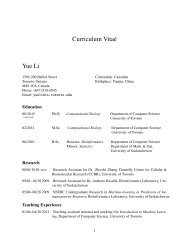Lecture notes on phylogenetic trees
Lecture notes on phylogenetic trees
Lecture notes on phylogenetic trees
You also want an ePaper? Increase the reach of your titles
YUMPU automatically turns print PDFs into web optimized ePapers that Google loves.
<str<strong>on</strong>g>Lecture</str<strong>on</strong>g> Notes – Phylogenetic Trees Tomas Babak<br />
Distances:<br />
We have seen many ways to measure distances between several organisms – Jukes-<br />
Cantor, edit distance, rearrangement (inversi<strong>on</strong>) distance. Now we will talk about how<br />
using these distances we can infer the phylogeny – evoluti<strong>on</strong>ary relati<strong>on</strong>ship – between<br />
various organisms.<br />
Phylogenetic Trees:<br />
Depicti<strong>on</strong> of substituti<strong>on</strong> distances that accurately depict comm<strong>on</strong> ancestors (i.e. when<br />
two different genomes were identical).<br />
e.g.<br />
Dem<strong>on</strong>strates that A, B, C, and D shared a comm<strong>on</strong> ancestor, but we d<strong>on</strong>’t know when<br />
(unrooted tree). To find out where al<strong>on</strong>g the horiz<strong>on</strong>tal line comm<strong>on</strong> ancestor exist, we<br />
need an outgroup (an organism that diverged prior to existence of comm<strong>on</strong> ancestor). In<br />
other words, the outgroup defines the distance to comm<strong>on</strong> ancestry between the two<br />
highest nodes <strong>on</strong> a hierarchical tree (the two ancestors adjoining the root of the tree). For<br />
example if A, B, C, and D were human, chimp, mouse, and rat as shown below.<br />
Defines positi<strong>on</strong> of<br />
comm<strong>on</strong> ancestor<br />
human chimp mouse rat<br />
fish<br />
fish defines the distance from the mouse-rat comm<strong>on</strong> ancestor and human-chimp<br />
comm<strong>on</strong> ancestor to the comm<strong>on</strong> ancestor of both lineages.
<str<strong>on</strong>g>Lecture</str<strong>on</strong>g> Notes – Phylogenetic Trees Tomas Babak<br />
Building Trees<br />
There are two types of approaches to building <strong>trees</strong>: (i) Distance based methods, which<br />
work from pairwise distances between the sequences (e.g. UPGMA, Neighbour Joining),<br />
(ii) character-based methods, which work directly from multiply aligned sequences (e.g.<br />
parsim<strong>on</strong>y and likelihood approaches; these were not covered in class).<br />
Distance Methods<br />
UPGMA<br />
A straightforward method to draw a tree is a greedy clustering approach called the<br />
Unweighted Pair Group Method using Arithmetic Averages (UPGMA). A tree is drawn<br />
by recursively joining two closest nodes, grouping them into <strong>on</strong>e cluster, and treating<br />
them as single node to which new distances are calculated. This is d<strong>on</strong>e until <strong>on</strong>ly two<br />
nodes remain.<br />
Suppose you are given four sequences separated by the following distances:<br />
A<br />
B 4<br />
A B C D<br />
C 5 8<br />
D 7 9 7<br />
To c<strong>on</strong>struct the tree we begin with a star tree, where the initial branch point is arbitrary.<br />
A<br />
B<br />
A and B are the closest so let’s group them under a new node called F and calculate the<br />
distances to the new node:<br />
C<br />
D
<str<strong>on</strong>g>Lecture</str<strong>on</strong>g> Notes – Phylogenetic Trees Tomas Babak<br />
The distance from C to F can be calculated as:<br />
d(<br />
C,<br />
B)<br />
+ d(<br />
C,<br />
A)<br />
! d(<br />
A,<br />
B)<br />
d(<br />
C,<br />
F)<br />
=<br />
2<br />
You divide by 2 because you covered the path from C to F twice. The distance matrix<br />
then becomes:<br />
F<br />
C 4.5<br />
F C D<br />
D 6 7<br />
F and C are now closest, repeating the procedure by grouping C and F into G produces<br />
the following tree:<br />
A<br />
B<br />
A<br />
B<br />
F<br />
F G<br />
N.B. This is still an unrooted tree as we do not know when C and D diverged.<br />
C<br />
UPGMA produces the correct tree when the mutati<strong>on</strong> rates al<strong>on</strong>g all branches are equal,<br />
however, this is not always the case. C<strong>on</strong>sider the following <strong>phylogenetic</strong> tree (known to<br />
be correct):<br />
D<br />
C<br />
D
<str<strong>on</strong>g>Lecture</str<strong>on</strong>g> Notes – Phylogenetic Trees Tomas Babak<br />
(http://www.icp.ucl.ac.be/~opperd/private/neighbor.html)<br />
In this case B diverged more quickly than A. Thus, UPGMA would join A and C<br />
producing an incorrect tree topology. Neighbour Joining (NJ) was developed to take<br />
n<strong>on</strong>-uniform divergence rates into account. The idea is to produce a modified distance<br />
matrix that takes into account the net divergence rate of the entire tree, so that nodes<br />
close together but far apart from all other nodes are not necessarily joined directly.<br />
Saitou and Nei (1987) derived a model for calculating the modified matrix. If d is the<br />
original distance matrix, the modified matrix<br />
D ij = dij<br />
! ( Ri<br />
+ R j )<br />
where,<br />
1<br />
R i = dim.<br />
N # 2<br />
!<br />
m"<br />
N<br />
N is the set of leaves in the tree. The number of leaves is | N |. The tree topology is<br />
c<strong>on</strong>structed as described above (UPGMA) using the modified distance matrix D. Attes<strong>on</strong><br />
(1999) proved this model to be correct under the assumpti<strong>on</strong> that the we are dealing with<br />
an additive tree (i.e. for any two leaves the distance between them is the sum of edges<br />
al<strong>on</strong>g a path that c<strong>on</strong>nects them).<br />
Suppose you have the following distance matrix d (corresp<strong>on</strong>ding to the above tree):<br />
,<br />
Ri, the net divergence matrix for each sequence is calculated as the sum of each node to<br />
all other nodes.
<str<strong>on</strong>g>Lecture</str<strong>on</strong>g> Notes – Phylogenetic Trees Tomas Babak<br />
R(A) = (5+4+7+6+8)/4 = 30/4,<br />
R(B) = 42/4,<br />
R(C) = 32/4,<br />
R(D) = 38/4,<br />
R(E) = 34/4,<br />
R(F) = 44/4.<br />
D is:<br />
It is now apparent that D and E, and A and B are closest and these are initially joined as<br />
neighbours.<br />
Sample calculati<strong>on</strong> for Dij:<br />
D<br />
D<br />
D<br />
D<br />
ij<br />
AB<br />
AB<br />
AB<br />
= d<br />
ij<br />
= d<br />
! ( R + R<br />
AB<br />
! ( R<br />
A<br />
30 42<br />
= 5 ! ( + )<br />
4 4<br />
= ! 13<br />
i<br />
j<br />
)<br />
+ R<br />
B<br />
)<br />
We can now use the greedy algorithm to c<strong>on</strong>struct the tree. We would start by joining A<br />
and B (AB->S), since this is <strong>on</strong>e of the minima of D (we could have also joined D and E,<br />
the other minimum), and recompute the distances to S (nodes joining AB; see figure<br />
below).<br />
B<br />
A<br />
C<br />
F<br />
D<br />
E<br />
B<br />
A<br />
C<br />
S<br />
F<br />
D<br />
E
<str<strong>on</strong>g>Lecture</str<strong>on</strong>g> Notes – Phylogenetic Trees Tomas Babak<br />
Subbing in S for A and B, we can calculate the distances from the remaining nodes to S,<br />
d(CS) = d(AC) + d(BC) - d(AB) / 2 = 3<br />
d(DS) = d(AD) + d(BD) - d(AB) / 2 = 6<br />
d(ES) = d(AE) + d(BE) - d(AB) / 2 = 5<br />
d(FS) = d(AF) + d(BF) - d(AB) / 2 = 7<br />
d becomes:<br />
S C D E F<br />
S<br />
C 3<br />
D 6 7<br />
E 5 6 5<br />
F 7 8 9 8<br />
Where D is:<br />
S C D E F<br />
S<br />
C -19.5<br />
D -18 -18.5<br />
E -17.5 -18 -20.5<br />
F -19.5 -20 -19 -20<br />
We would next join D and E -> T.<br />
B<br />
A<br />
C<br />
S<br />
F<br />
D<br />
E<br />
We would c<strong>on</strong>tinue to join nodes, recalculate d and D until <strong>on</strong>ly two nodes remain.<br />
B<br />
A<br />
C<br />
S<br />
F<br />
T<br />
D<br />
E



